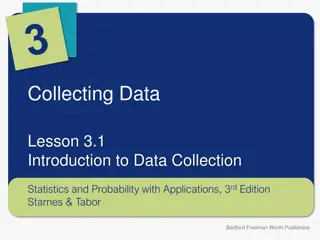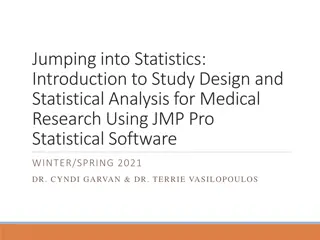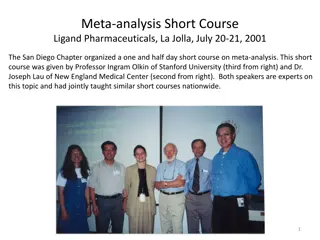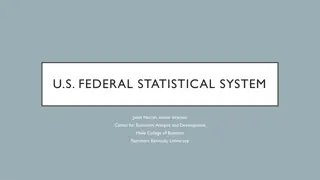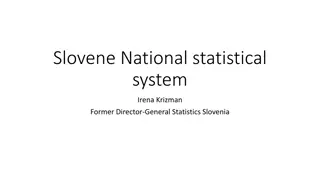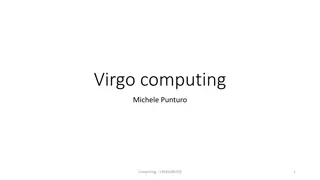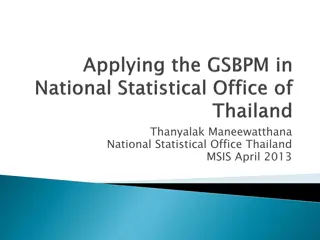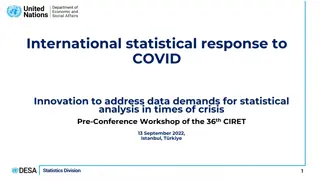Overview of R Language for Statistical Computing and Data Analysis
R is a powerful language widely used for statistical computing and data analysis. It offers extensive library support and various programming paradigms such as procedural, functional, and object-oriented. With capabilities similar to Matlab for general matrix computation, R provides a versatile platform for data manipulation and visualization.
Download Presentation

Please find below an Image/Link to download the presentation.
The content on the website is provided AS IS for your information and personal use only. It may not be sold, licensed, or shared on other websites without obtaining consent from the author.If you encounter any issues during the download, it is possible that the publisher has removed the file from their server.
You are allowed to download the files provided on this website for personal or commercial use, subject to the condition that they are used lawfully. All files are the property of their respective owners.
The content on the website is provided AS IS for your information and personal use only. It may not be sold, licensed, or shared on other websites without obtaining consent from the author.
E N D
Presentation Transcript
The R Language 1 Dr. Smruti R. Sarangi and Ms. Hameedah Sultan Computer Science and Engineering IIT Delhi
Overview of R 2 Language for statistical computing and data analysis Freely available under GPL v2 Extensive library support Programming paradigms procedural functional object-oriented General matrix computation (similar to Matlab)
Running R 3 Command Line Just type R The R command prompt comes up > ..... With a GUI R Studio R Commander
Outline 4 Variables and Vectors Factors Arrays and Matrices Data Frames Functions and Conditionals Graphical Procedures
Normal Variables 5 We can use <- as the assignment operator in R > x <- 4 (set x to 4) For printing the value of x > x [1] 4 OR, > print(x) [1] 4
A Numeric Vector 6 Simplest data structure Numeric vector > v <- c(1,2,3) <- is the assignment operator c is the list concatenation operator To print the value, v Type : > v Output: [1] 1 2 3
A vector is a full fledged variable 7 Let us do the following: > 1/v [1] 1.0000000 0.5000000 0.3333333 > v + 2 [1] 3 4 5 We can treat a vector as a regular variable For example, we can have: > v1 <- v / 2 > v1 [1] 0.5 1.0 1.5
Creating a vector with vectors 8 > v <- c (1,2,3) > v [1] 1 2 3 > vnew <- c (v,0,v) > vnew [1] 1 2 3 0 1 2 3 The c operator concatenates all the vectors
Functions on Vectors and Complex Numbers 9 If v is a vector Here, are a few of the functions that take vectors as inputs: mean(v), max(v), sqrt(v), length(v), sum(v), prod(v), sort (v) (in ascending order) > x <- 1 + 1i > y <- 1i > x * y [1] -1+1i
Generating Vectors 10 Suppose we want a vector of the form: (1,2,3,... 100) We do not have to generate it manually. We can use the following commands: > v <- 1:100 OR > v <- seq(1,100) seq takes an additional argument, which is the difference between consecutive numbers: seq (1,100,10) gives (1,11,21,31 ... , 91) rep (2,5) generates a vector (2, 2, 2, 2, 2)
Boolean Variables and Vectors 11 R recognizes the constants: TRUE, FALSE TRUE corresponds to 1 FALSE corresponds to 0 We can define a vector of the form: v <- c (TRUE, FALSE, TRUE) We can also define a logical vector Can be created with logical operators: <, <=, >=, ==, !=, & and I > v <- 1:9 > 5 > v [1] FALSE FALSE FALSE FALSE FALSE TRUE TRUE TRUE TRUE
String Vectors 12 Similarly, we can have a vector of strings > vec <- c ( f1 , f2 , f3 ) > vec [1] "f1" "f2" "f3 The paste function can be used to create a vector of strings paste(1:3, 3:5,sep="*") [1] "1*3" "2*4" "3*5" It takes two vectors of the same length, and an optional argument, sep. The ith element of the result string, contains the ith elements of both the arguments, separated by the string specified by sep.
Outline 13 Variables and Vectors Factors Arrays and Matrices Data Frames Functions and Conditionals Graphical Procedures
Factors 14 Factor Definition: A vector used to specify a grouping (classification) of objects in other vectors. Consider the following problem: We have a vector of the type of the Nationality of students, and a vector of their marks in a given subject. AIM: Find the average scores per nationality.
Graphical View of the Problem 15 Indian 6 Chinese 8 Indian Indian 7 Chinese Chinese 9 Russian Indian 8 Factor Russian 10 Nationality Marks
# character starts a comment Code 16 > nationalities <- c ("Indian", "Chinese", "Indian", "Chinese", "Indian", "Russian") # create a factor > marks <- c (6, 8, 7, 9, 8, 10) > fac <- factor(nationalities) > fac [1] Indian Chinese Indian Chinese Indian Russian Levels: Chinese Indian Russian The levels of a factor indicate the categories
Code - II 17 Now let us apply the factor to the marks vector > results <- tapply (marks, fac, mean) compute the mean in each category Works on each element of the list factor List of marks
Time for the results 18 > results Chinese Indian Russian 8.5 7.0 10.0 Let us now apply the sum function > tapply (marks, fac, sum) Chinese Indian Russian 17 21 10
levels and table 19 > levels (fac) [1] "Chinese" "Indian" "Russian" > table (fac) fac Chinese Indian Russian 2 3 1 Let us assume that the factor is fac. fac is [1] Indian Chinese Indian Chinese Indian Russian Levels: Chinese Indian Russian levels returns a vector containing all the unique labels table returns a special kind of array that contains the counts of entries for each label
Outline 20 Variables and Vectors Factors Arrays and Matrices Data Frames Functions and Conditionals Graphical Procedures
Arrays and Matrices 21 Generic array function Creates an array. Takes two arguments: data_vector vector of values dimension_vector Example: > array (1:10, c(2,5)) [,1 [,2] [,3] [,4] [,5] [1,] 1 3 5 7 9 [2,] 2 4 6 8 10 The numbers are laid out in column major order. Count from 1, Not 0
Other ways to make arrays 22 Take a vector, and assign it dimensions > v <- c (1,2,3,4) > dim(v) <- c(2,2) > v [,1] [,2] [1,] 1 3 [2,] 2 4
Arrays are Created in Column Major Order > v <- 1:8 > dim(v) <- c(2,2,2) > v , , 1 23 [,1] [,2] [1,] 1 3 [2,] 2 4 Start from the last index , , 2 Array elements are accessed by specifying their index (within square brackets) [,1] [,2] [1,] 5 7 [2,] 6 8 > v[2,1,2] [1] 6
The matrix command 24 A matrix is a 2-D array There is a fast method of creating a matrix Use the matrix (data, dim1, dim2) command Example: > matrix(1:4, 2, 2) [,1] [,2] [1,] 1 3 [2,] 2 4
cbind and rbind 25 mat1 mat2 mat1 mat2 cbind mat1 mat1 mat2 mat2 rbind
Problem: set the diagonal elements of a matrix to 0 26 > mat <- matrix(1:16,4,4) > mat [,1] [,2] [,3] [,4] [1,] 1 5 9 13 [2,] 2 6 10 14 [3,] 3 7 11 15 [4,] 4 8 12 16 > indices <- cbind (1:4, 1:4) > mat[indices] <- 0 > mat [,1] [,2] [,3] [,4] [1,] 0 5 9 13 [2,] 2 0 10 14 [3,] 3 7 0 15 [4,] 4 8 12 0
Recycling Rule 27 > cbind (1:4, 1:8) [,1] [,2] [1,] 1 1 [2,] 2 2 [3,] 3 3 [4,] 4 4 [5,] 1 5 [6,] 2 6 [7,] 3 7 [8,] 4 8 The smaller structure is replicated to match the length of the longer structure Note that the size of the longer structure has to be a multiple of the size of the smaller structure.
Matrix Operations 28 A * B is a normal element-by-element product A %*% B is a matrix product Equation solution: solve (A, b) (for equations of the form Ax = b) solve (A) returns the inverse of the matrix > A <- matrix (1:4, 2, 2) > b <- 5:6 > solve (A,b) [1] -1 2 Solve an equation of the form: Ax = b > solve(A) %*% b [,1] [1,] -1 [2,] 2 A-1 * b = x
Additional Features nrow (mat) Number of rows in the matrix ncol (mat) Number of columns in the matrix 29 Feature Eigen Values Singular Value Decomposition Least Squares Fitting QR decomposition Function eigen svd lsfit qr
Outline 30 Variables and Vectors Factors Arrays and Matrices Data Frames Functions and Conditionals Graphical Procedures
Lists and Data Frames 31 A list is a heterogeneous data structure It can contain data belonging to all kinds of types Example: > lst <- list ( one , 1, TRUE) Elements can be lists, arrays, factors, and normal variables The components are always numbered They are accessed as follows: lst[[1]], lst[[2]], lst[[3]] [[ ... ]] is the operator for accessing an element in a list
Named Components 32 Lists can also have named components lst <- list(name= Sofia , age=29, marks=33.7) The three components are: lst$name, lst$age, lst$marks We can also use lst [[ name ]], lst[[ age ]], lst [[ marks ]]
Data Frames columns 33 rows Data Frame It is a table in R > entries <- c( cars , trucks , bikes ) > price <- c (8, 10, 5) > num <- c (1, 2, 3) > df <- data.frame(entries, price, num) > df entries price num 1 cars 8 1 2 trucks 10 2 3 bikes 5 3
Accessing an Element 34 Can be accessed as a regular array, or as a list > df[1,2] [1] 8 Row names, i.e. character values > df[2,] entries price num 2 trucks 10 2 > df$price [1] 8 10 5 Summary shows a summary of each variable in the data frame > summary(df) entries price num bikes :1 Min. : 5.000 Min. :1.0 cars :1 1st Qu.: 6.500 1st Qu.:1.5 trucks:1 Median : 8.000 Median :2.0 Mean : 7.667 Mean :2.0 3rd Qu.: 9.000 3rd Qu.:2.5 Max. :10.000 Max. :3.0 Feature Show first 6 rows of df List objects Remove variables x & y from data frame Sort df on variable x Function head(df) ls() rm(x,y) [order(df$x),]
Operations on Data Frames 35 A data frame can be sorted on the values of a variable, filtered using values of a variable, and grouped by a variable. Eg. Filter rows where entries = cars > df[df$entries == "cars",] entries price num 1 cars 8 1 Group by entries > aggregate(df,by = list(entries), mean) Group.1 entries price num 1 bikes NA 5 3 2 cars NA 8 1 3 trucks NA 10 2
Reading Data from Files 36 Reads in a data frame from a file Steps: Store the data frame in a file Read it in > df <- read.table ( <filename> ) Access the data frame
Outline 37 Variables and Vectors Factors Arrays and Matrices Data Frames Functions and Conditionals Graphical Procedures
Grouping, Loops, Conditional Execution R does have support for regular if statements, while loops, and other conditionals if statement if (condition) statement 1 else statement 2. Use {} for creating grouped statements The condition should evaluate to a single variable (not a vector) Example: 38 > x <- 3 > if (x > 0) x <- x+ 3 else x <- x + 6 > x [1] 6
For loop for (var in expr1) { .... .... } 39 > for (v in 1:10) print (v) [1] 1 [1] 2 [1] 3 [1] 4 [1] 5 [1] 6 [1] 7 [1] 8 [1] 9 [1] 10 Example:
While loop 40 > while (x[i] < 10) { + print (x[i]) + i <- i + 1 + } [1] 1 [1] 2 [1] 3 [1] 4 [1] 5 [1] 6 [1] 7 [1] 8 [1] 9 Use the break statement to exit a loop
Writing ones own functions 41 > cube <- function (x) { + x * x * x + } > cube(4) [1] 64 A function takes a list of arguments within ( ... ) To return a value, just print the expression (without assignment statements) Function calling convention similar to C
Applying a Function 42 > lapply (1:2,cube) [[1]] [1] 1 [[2]] [1] 8 Apply the cube function to a vector Applies the function to each and every argument sapply returns a list > sapply (1:3, cube) [1] 1 8 27
Named arguments 43 > fun <- function (x=4, y=3) { x - y } > fun() [1] 1 > fun (4,3) [1] 1 > fun (y=4, x=3) [1] -1 Possible to specify default values in the function declaration If a variable is not specified, the default value is used We can also specify the values of the variables by the name of the argument (last line)
Scoping in R 44 > deposit <- function (amt) balance + amt > withdraw <- function (amt) balance - amt > balance <- withdraw(10) > balance <- deposit (20) > balance [1] 110 Scope of variables in R Function arguments (valid only inside the function) Local variables (valid only inside the function) Global variables (balance)
Functional Programming: Closures 45 > exponent <- function (n) { + power <- function (x) { + x ** n + } + } > square <- exponent(2) > square(4) [1] 16 A function with pre-specified data is called a closure exponent returns a function power (with n = 2)
http://adv-r.had.co.nz/Functional-programming.html source Example: Numerical Integration > composite <- function(f, a, b, n = 10, rule) { 46 area <- 0 + points <- seq(a, b, length = n + 1) + + area <- 0 + for (i in seq_len(n)) { + area <- area + rule(f, points[i], points[i + 1]) + } + + area + } > midpoint <- function(f, a, b) { + (b - a) * f((a + b) / 2) + } > composite(sin, 0, pi, n = 1000, rule = midpoint) [1] 2.00000 Function for numerical integration Midpoint rule function passed as an argument ? sin ? ?? 0
Outline 47 Variables and Vectors Factors Arrays and Matrices Data Frames Functions and Conditionals Graphical Procedures
Plotting a Function 48 A basic 2D plot: Plot type (overplotted) vec1 <-cube(seq(1,100,10)) vec2 <-cube(seq(5,100,10)) plot(vec1, type="o", col="blue , ylim=c(0,3e5)) title(main= Plot of Cubes", col.main="red") To add a line to the same plot: lines(vec2, type= o", lty = 2, pch = 22, col= red ) Line type: Marker type: square dashed To add a legend: legend(1, max(vec1), c( vec1", vec2"), cex=0.8, col=c("blue","red"), pch=21:22, lty=1:2)
Plotting: Linear Regression 49 library("MASS") data(cats) # load data plot(cats$Bwt, cats$Hwt) # scatter plot of cats body weight vs heart rate M <- lm(formula = cats$Hwt ~ cats$Bwt, data=cats) # fit a linear model regmodel <- predict(M) # predict values using this model plot(cats$Bwt, cats$Hwt, pch = 16, cex = 1.3, col = "blue", main = "Heart rate plotted against body weight of cats", xlab = "Body weight", ylab = "Heart rate") # scatter plot abline(M) # plot the regression line
Creating 3-D plots 50 Packages plot3D, ggplot2 contain useful 3D plotting options plot3d, scatter3d, surf3d, persp3d are some of the commonly used plots. plot3d is from package rgl. It allows creating interactive 3D plots that can be rotated using the mouse. plot3d(x, y, z, col="red", size=3)




